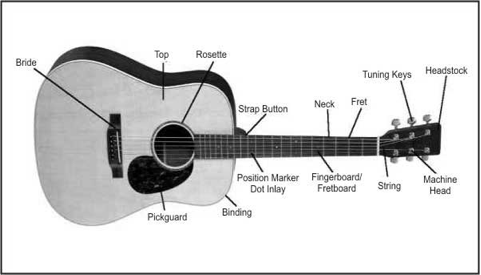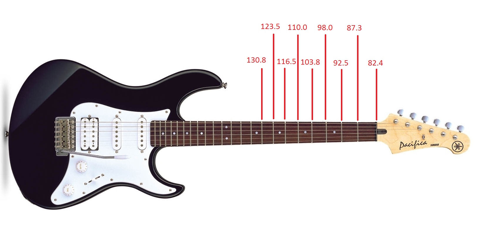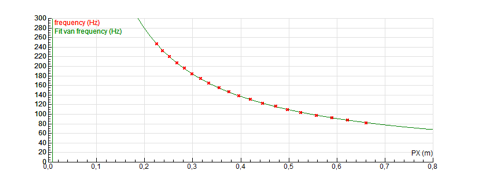| Learning Aims: |
|
| Materials: |
|
| Suggestions for use: |
|
In this activity students measure the length of the string shorted by using guitar frets and the corresponding natural frequency of the shorted string. Based on the measurements they determine the relation between the natural frequency of the string and its length (f ≈ 1/L). It is highly recommended to do measurements with a real guitar and to have one guitar for 3 or 4 students. Try to get some guitars from the music teacher or let the students bring their own guitar. A bass guitar or any other fretted instrument (ukulele, banjo, mandolin) will do as well. It also might be useful to know some parts of the guitar by name, see the picture below.
If there is no guitar available, the following data can be used:
or other data can be found on the internet: http://entertainment.howstuffworks.com/guitar3.htm or http://www.physics247.com/physics-tutorial/guitar-string-harmonics.shtml Hand out the Worksheet:Fundamental frequency, guitar. Let the students do their measurements and check these data during the measurements. There might be small differences between the different types of guitar but in general the values measured will be similar. The diagrams should all have the same shape, similar to the one showed below.
The relation between f and L is f = v / 2L. Here, f is frequency in Hertz, Besides this measurement, students might want to check the ratio between two string lengths with just one fret between them. If we define the length from the string, measured from the bridge to the n-th fret as Ln, then the ratio Ln /Ln+1 is a constant. This is supposed to be Ln /Ln+1 = 1.06 (start to number n at the machine head). There is a lot of material about the physics of a guitar available on the internet. You might want to check these sources: http://www.physics247.com/physics-tutorial/guitar-string-harmonics.shtml http://www.cs.helsinki.fi/u/wikla/mus/Calcs/wwwscalc.html Teachers who have access to Physics Teacher Online might want to read ‘Experimenting with Guitar Strings’ by Michael C. LoPresto:http://tpt.aapt.org/resource/1/phteah/v44/i8/p509_s1?isAuthorized=no |
| Possible questions: |
|


